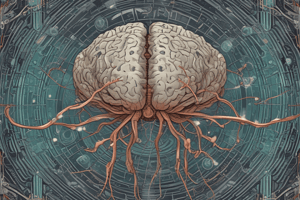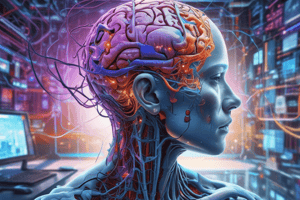Podcast
Questions and Answers
What is a brain-computer interface (BCI)?
What is a brain-computer interface (BCI)?
A brain-computer interface is a direct communication pathway between the brain's electrical activity and an external device, such as a computer or robotic limb.
When did research on BCIs begin?
When did research on BCIs begin?
Research on BCIs began in the 1970s by Jacques Vidal at the University of California, Los Angeles (UCLA) under a grant from the National Science Foundation, followed by a contract from DARPA.
What are the different types of BCI implementations mentioned in the text?
What are the different types of BCI implementations mentioned in the text?
Implementations of BCIs range from non-invasive (EEG, MEG, MRI) and partially invasive (ECoG and endovascular) to invasive (microelectrode array), based on how close electrodes get to brain tissue.
When did the first neuroprosthetic devices implanted in humans appear?
When did the first neuroprosthetic devices implanted in humans appear?
What was the first appearance of the expression 'brain-computer interface' in scientific literature?
What was the first appearance of the expression 'brain-computer interface' in scientific literature?
Flashcards are hidden until you start studying
Study Notes
Brain-Computer Interface (BCI)
- A brain-computer interface (BCI) is a system that enables people to control devices or communicate with others using only their brain signals.
History of BCI Research
- Research on BCIs began in the 1970s.
- The first neuroprosthetic devices implanted in humans appeared in the 1990s.
- The term "brain-computer interface" was first used in scientific literature in 1973.
Studying That Suits You
Use AI to generate personalized quizzes and flashcards to suit your learning preferences.





